Have you ever wondered why your pet looks like a furry doughnut when they sleep? There’s an evolutionary reason behind your dog’s tendency to curl up into a ball for slumber. Understanding this peculiar sleeping position provides insight into your best friend’s health, psychology, and natural biology. So, why do dogs curl up when they sleep?
We will cover the mystery of why dogs coil into snug-ball of fur at bedtime and reveal how to ensure your pup gets the highest quality zzz’s. From muscle relaxation to thermoregulation, your dog’s sleep curl provides surprising benefits beyond just looking adorable.
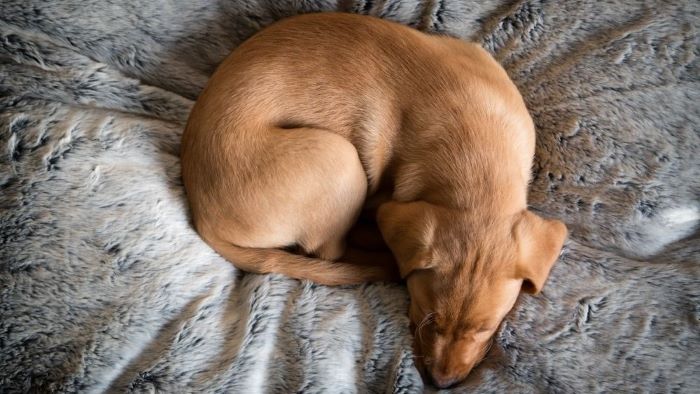
Why Do Dogs Curl Up When They Sleep?
There are several key reasons why dogs usually curl up into tight balls when sleeping:
Conserving Body Heat
Curling into a ball conserves a dog’s body heat. Dogs have a higher ratio of surface area to body mass compared to humans. This shape causes them to lose heat more rapidly. Tucking their paws in toward their body and curling into a ball helps retain more body heat and maintain their temperature. It provides insulation against cold floors or environments.
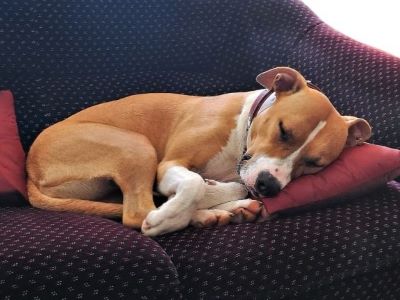
Protecting Vital Organs
Sleeping in a curled position protects a dog’s vital organs, including the heart, lungs, and abdomen. Tucking in their paws and tail secures these vulnerable body parts. It also shields them from potential attacks when sleeping in the wild. The curled shape makes it harder for predators to get a dog’s belly and neck area.
Feeling Secure
The curled sleep position provides dogs with a sense of security, comfort, and safety. It’s a self-soothing posture that makes them protected. Dogs often sleep in this position when they are anxious, scared, stressed, or unsure about their surroundings. The tight ball posture sends calming signals to their brain.
Muscle Relaxation
Curling up allows a dog’s muscles to completely relax during sleep. Keeping the body tucked in prevents them from stretching too far and maintains joint alignment. This takes pressure off the muscles and allows them to rest. It’s the most effective sleep position for overall muscle relaxation. This might be the most relevant answer to “Why Do Dogs Curl Up When They Sleep“
Key Benefits of Curling Up
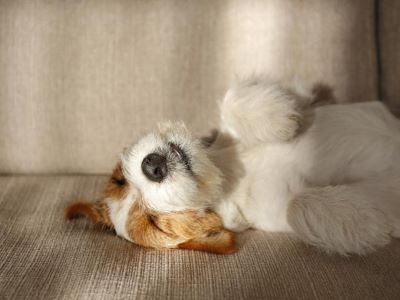
In addition to the reasons dogs curl up, the position also provides some important benefits:
Thermoregulation
The insulated ball shape helps dogs efficiently regulate their body temperature. It prevents heat loss on cold surfaces while also preventing overheating. The compact posture allows dogs to produce more heat when needed easily.
Joint and Muscle Support
Sleeping in a curled position compresses and supports a dog’s joints and muscles. It prevents over-extension and also allows connective tissues to rest. This helps alleviate discomfort from arthritis, joint injuries, muscle strains, or bone conditions.
Comfort and Calming Effects
The tight curled ball posture has demonstrated calming effects in dogs. It releases tension in the body and mind for a deeper, more restful sleep. Dogs are also thought to associate posture with feelings of comfort and security from when they were puppies sleeping near their mother.
Factors Affecting Curling Up
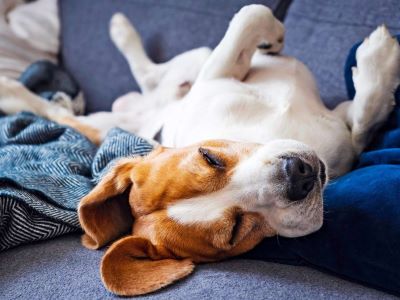
Several factors influence whether dogs curl up as well as the extent to which they curl their body:
Breed – Some breeds are more likely to sleep in a curled ball than others based on body shape, size and fur thickness. For example, Greyhounds do not curl as tightly due to their lean shape. Long-haired breeds may curl up more to keep their fur insulated.
Age – Puppies and older dogs tend to curl up more to preserve body heat and rest their muscles/joints. Senior dogs also curl tightly for comfort and feelings of security as they experience cognitive decline.
Health Condition – Dogs with anxiety, pain or illness may curl up more due to discomfort or a self-soothing posture. But dogs with conditions like arthritis may stretch out instead to relieve aching joints.
Temperature – Dogs curl up tighter in colder environments or weather to conserve heat. When it’s hot, they will stretch out on cool surfaces to prevent overheating and allow heat dissipation.
Sleep Stage – Dogs may stretch out when in REM sleep but will curl up tighter when in deep, restorative sleep stages to maintain optimal muscle and joint recovery.
Common Curling Positions and Meanings
Dogs curl up in many positions, each having slightly different implications[1]:
Tight Ball – When dogs sleep in a very tight, compact ball with their tail tucked, it often signals they are cold, anxious, or distressed. This is the most protective posture.
Half Curl – The half curl with the head tucked and paws drawn in partway indicates a moderately restful state. This is the most common curling position.
Full Stretch – Fully stretched-out positions show dogs are extremely relaxed and comfortable in their surroundings. This leaves vital organs exposed.
On back – When dogs sleep on their back with their belly exposed, this demonstrates they feel extremely safe and secure in their environment.
On Side – Sleeping curled up but their side is a common position that allows dogs to easily shift between stretching out and curling up as needed.
When to Be Concerned About Curling Up
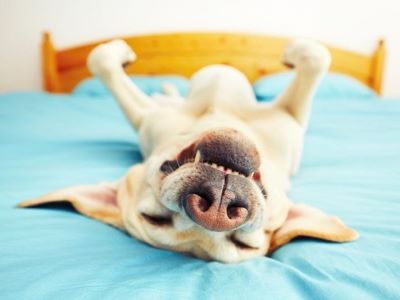
While curling up is normal, take note if your dog shows any of these signs:
- Whimpering, shaking, or pawing while curled up may indicate pain or anxiety.
- Difficulty standing up after prolonged curling could signal muscle stiffness or orthopaedic issues.
- Sudden changes in sleep positions, refusing to curl up, or odd body positioning may signify illness or injury.
- Excessive time spent curled up while awake may be due to depression, nausea, or fatigue.
If you notice any of these signs, don’t be confused in your question “Why Do Dogs Curl Up When They Sleep“, but consult your veterinarian to rule out an underlying health issue.
Tips for Better Dog Sleep
To ensure your dog experiences high-quality sleep, try these tips:
- Provide an orthopaedic dog bed with bolsters and cushioning to enhance comfort in the curled position.
- Maintain a comfortable ambient temperature between 60-68°F.
- Choose a quiet, tranquil area away from commotion for your dog to sleep undisturbed.
- Stick to a consistent sleep schedule and bedtime to promote relaxation.
- Make sure your dog gets adequate exercise and stimulation during the daytime hours.
FAQs
Why do dogs curl up when they sleep
Dogs curl up to conserve their body heat, protect their organs, relax their muscles, and feel safe/secure while sleeping. The tight ball posture provides comfort and calming effects for dogs.
Should I be concerned if my dog sleeps in a ball?
It’s perfectly normal and healthy for dogs to sleep curled up in a ball. Only be concerned if they show signs of pain, have trouble standing up, or there are sudden changes in their sleep habits.
What does it mean when dogs stretch out instead of curling up?
When dogs fully stretch out to sleep, it indicates they feel extremely safe and comfortable in their environment. It means they can fully relax their body.
Why does my dog curl up but not into a tight ball?
Partial curling with the paws drawn halfway is a prevalent position that provides moderate comfort and security for dogs while sleeping.
Why does my dog sleep curled up when it’s hot outside?
Dogs may still curl up in warmer weather to protect their organs out of instinct, even if they don’t need the heat insulation. The partial curl helps regulate their temperature so they don’t get too hot.
Conclusion
Curling up into a ball is an instinctive sleeping position for most canines. It provides thermoregulation, muscle relaxation, feelings of comfort and security, and protection for vital organs. While dogs naturally prefer to curl up, certain factors like health, age, and temperature can affect the position.
Monitoring your dog’s sleep habits provides insight into their well-being. If you notice any troubling changes in their sleep patterns, contact your vet. Encouraging restful sleep through a comfortable bed, ideal ambient temperature, exercise, and a soothing environment will support your dog’s health.
Reference:
- 6 Dog Sleeping Positions and What They Mean | petMD



